Here I go again, stepping in the ant pile…..hopeful I don’t get bit this time….
Ya’ll remember this tree that I teased you with a few posts back?
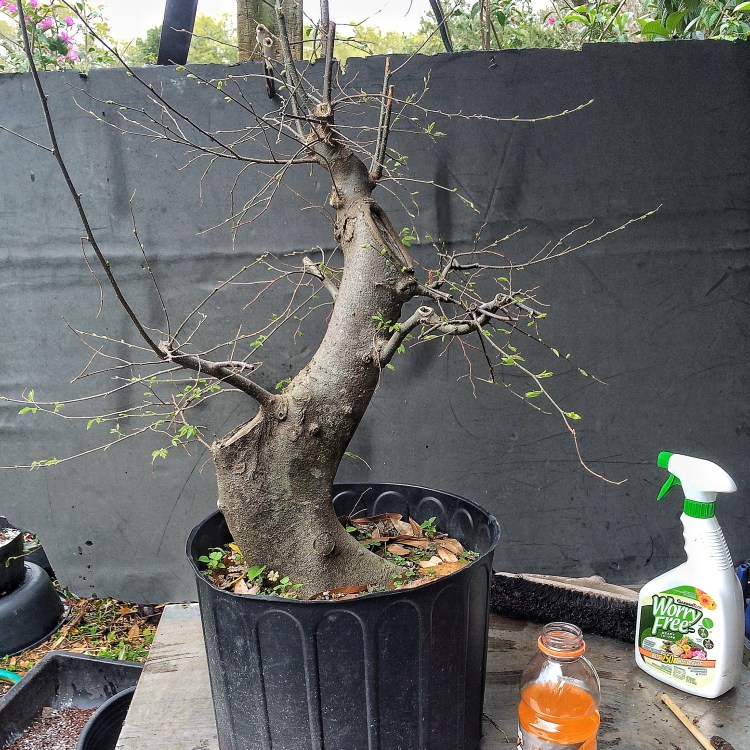
Well, we will get back to it towards the end of the post, but I must say, it’s a “bad tree”.
What do I mean by that, anyway? Let me put a scene, a situation, an act of a play, into your mind.
Ok, close your eyes…..wait, that won’t work, how will you be able to read what I’m writing……ok, close your mind’s eye and read what I’m writin’.
You are at your first bonsai club meeting, you’ve brought your pride and joy, a ficus you got at IKEA, and you have been working your courage up to go to this meeting for two weeks. You are a little apprehensive because you’re just not sure if this whole “bonsai club” thingy isn’t really just a front for a swingers society. You half hope that it is, but not really. After the program, you finally get that last bit of nerve up and you introduce yourself to that distinguished looking gentleman (or worse, lady) and, after some genteel conversation about maybe religion or politics (a safe conversation in a bonsai club, don’t ever talk about soil….) you show your, you think, beautiful specimen of a tree.
If you’ve been through this crucible, you know how it ends,
“That will never be a good bonsai, don’t waste your time, you shouldn’t waste your money on that piece of crap“
And this advice is always given in that “I know something you don’t know” tone. Very schoolyard.
To define a “bad” tree: One that is either a shape, variety, age, style or origin that has been determined by “them” to be unacceptable.
In the above situation, it was a ficus, probably a ginseng looking one, but it could have been an s-curve f. Microcarpa retusa. So we have an undesirable tree for variety (f. Microcarpa, ‘cuz everyone knows that tropical trees aren’t real bonsai) , for style (s-curve or ginseng), and for its origin, IKEA (Though I will be the first to admit that IKEA is the gateway to the expanse that the Catholics call Putgatory, but they do have some good stuff…if you dig hard. I mean, those tubes of crab are tasty…..)
 But the tree could be a Fukien tea (many people can’t grow them and automatically think they are “bad”), a mallsai juniper, a serissa, an oak, a schefflera, a Formosan azalea as opposed to a satsuki, a red cedar (juniperus virginiana), a red maple……the list goes on and on.
But the tree could be a Fukien tea (many people can’t grow them and automatically think they are “bad”), a mallsai juniper, a serissa, an oak, a schefflera, a Formosan azalea as opposed to a satsuki, a red cedar (juniperus virginiana), a red maple……the list goes on and on.
Let me give you some examples, starting with the much maligned “ginseng” ficus. Now, I apologize for shouting, but this must be said loudly- THERE IS NO SUCH THING AS A GINSENG FICUS!
“But..” you say “I see them for sale all the time! You’re just wrong!”
A ginseng ficus is nothing more than a ficus microcarpa var. microcarpa (the double name just means it’s the original) that was grown from seed. And just like an adenium (desert rose), an f. microcarpa will form a caudex (swollen root body). In fact, most ficus grown from seed will do this. But we don’t see many seed grown ficus because, for one, the wasps that fertilize ficus flowers are rare and, two, it’s so easy to propagate ficus from cuttings, why bother? So the “trunk” we see on a “ginseng” is really just the roots, raised above the soil line.
Sometimes the growers graft a different f. microcarpa variety foliage onto the top of these roots. Usually it’s done badly and only in one spot. Why do they bother? Well, It’s the real reason why f. microcarpa is a bad tree, not the ugly caudex.
Here we have a tree I’ve been developing for some time.
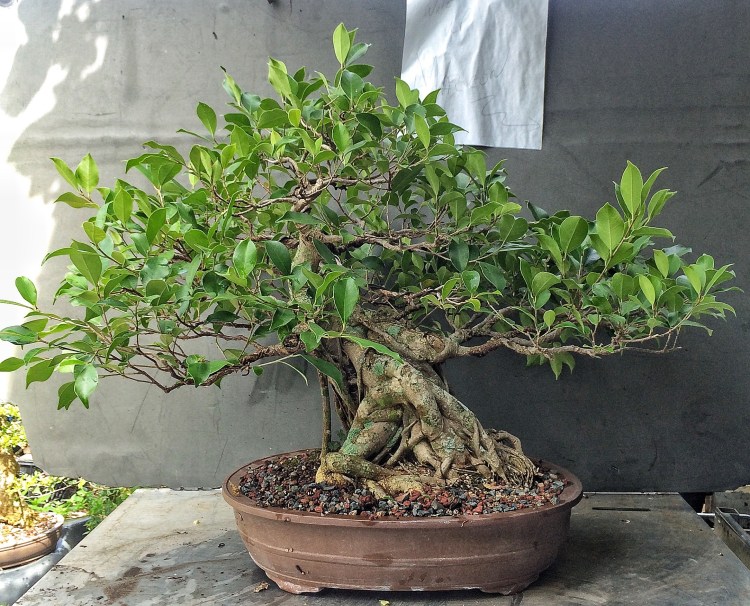
It’s a tad shaggy at the moment, needs a trim; I’ve let it grow over the winter. It’s currently in a topiary trimming stage, or what Walter Pall calls “hedge trim”. I’m trying to build ramification, a particularly hard thing to do on this variety. Here’s another example of f. microcarpa (it’s just out of the trunk building stage).

Notice the difference between the leaves.
 It takes quite a bit of work to reduce the size. That, and the sparseness of the foliage, and it’s tendency to die back to the next node, is why it’s a “bad” tree. Yet I still grow them. And, of course, it comes in the very non-tree like style called ginseng, so often. Yes, I do agree with you (you know who you are) I would offer my opinion that 90% of ginseng-style ficus are bad. In all my years in bonsai I’ve only found two that could be called decent.
It takes quite a bit of work to reduce the size. That, and the sparseness of the foliage, and it’s tendency to die back to the next node, is why it’s a “bad” tree. Yet I still grow them. And, of course, it comes in the very non-tree like style called ginseng, so often. Yes, I do agree with you (you know who you are) I would offer my opinion that 90% of ginseng-style ficus are bad. In all my years in bonsai I’ve only found two that could be called decent.
This one:
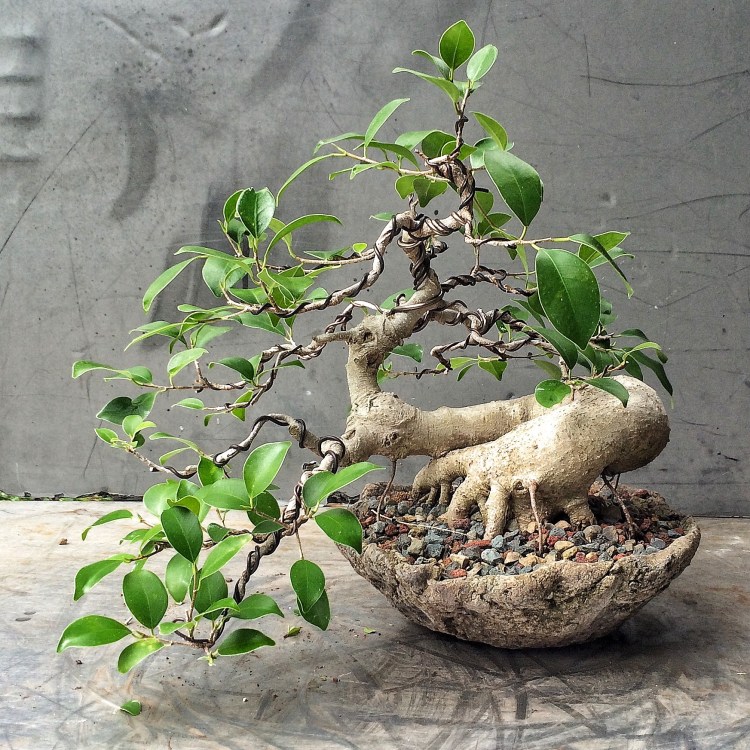 And this one:
And this one:

Which I found last year. Look at that trunk!

Getting back to the trees on my bench, I might as well do some pruning while I have them here.


A quick hack job on the above tree and then, just a little off the top on the bottom tree.
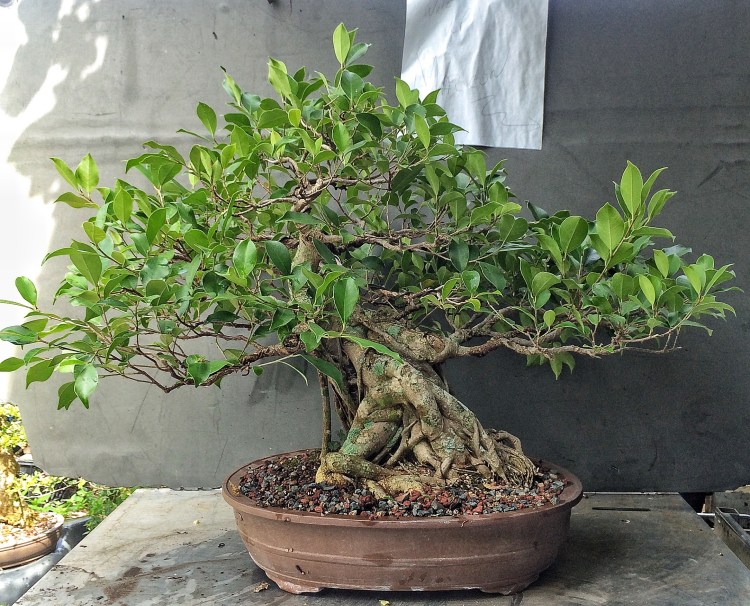
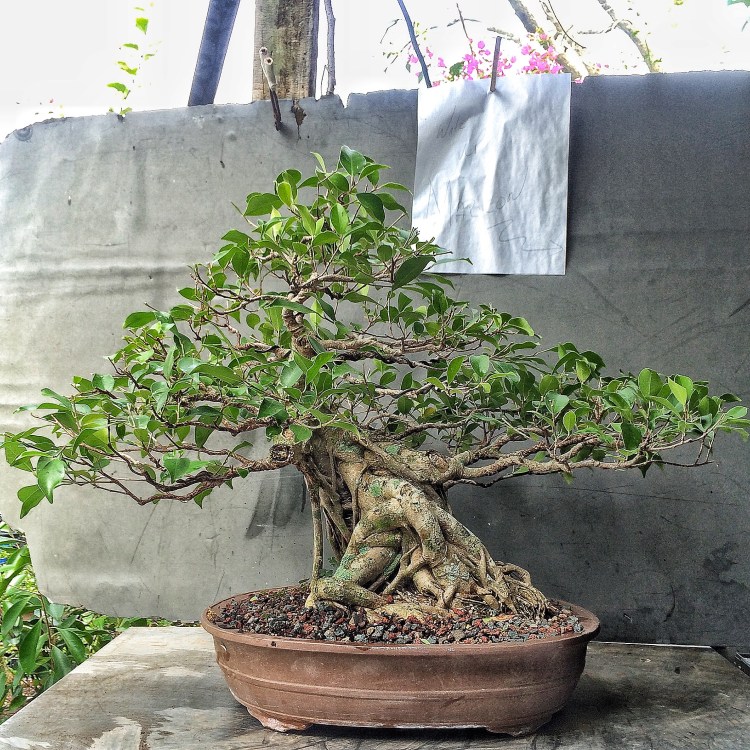
The next tree we will look at is a variety of podocarpus that’s undesirable.
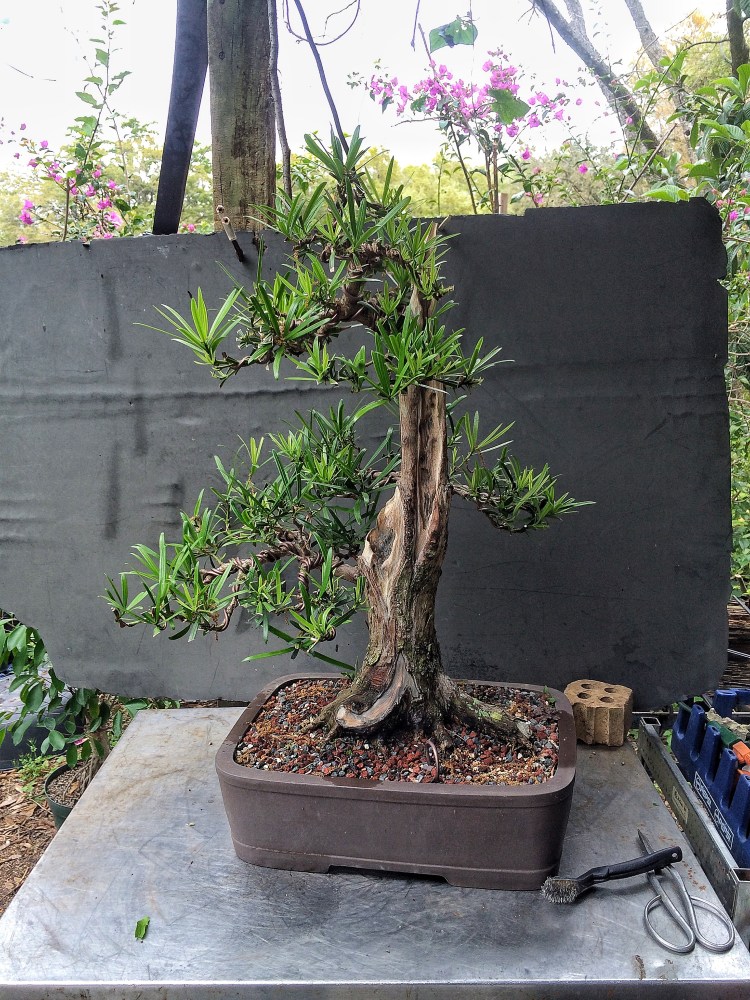
This variety has an unfortunately long leaf. It also has a structural flaw. Two things against it.

It takes a lot of work to get the leaf small, and it only stays small until the next years growth cycle.
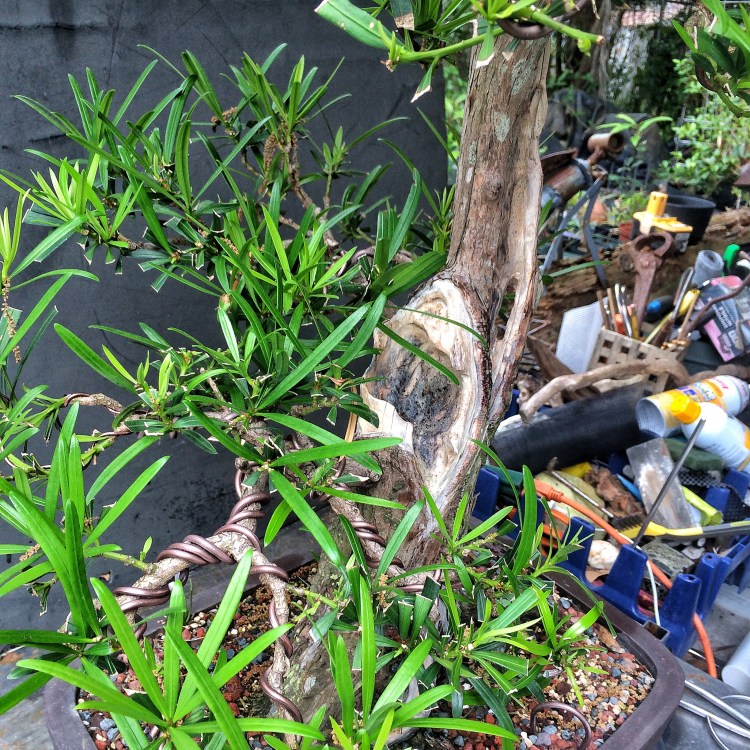
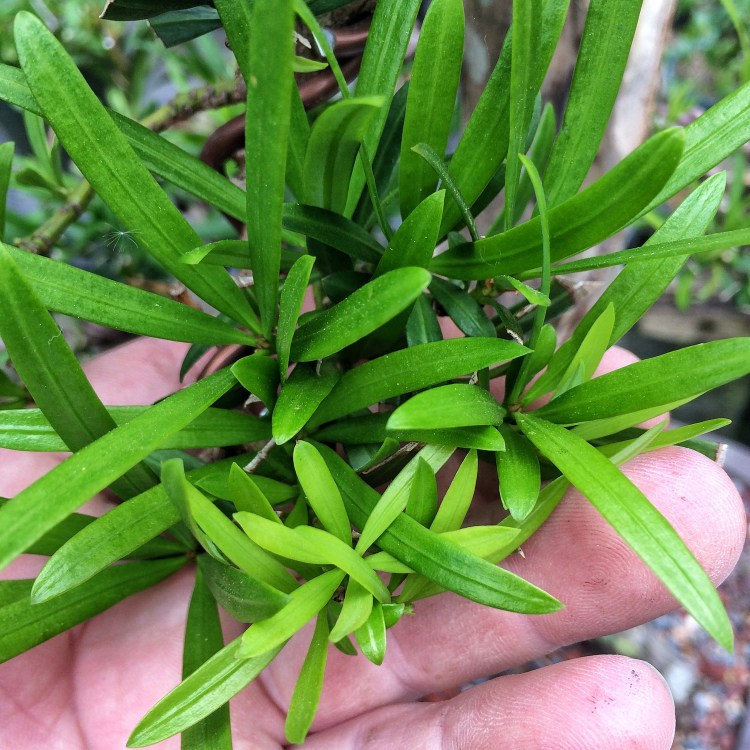
Here’s the structural defect:
 This long straight bit towards the top. You can’t bend this like you can a pine or juniper of the same thickness so, you either cut it or, as I do here, hide it.
This long straight bit towards the top. You can’t bend this like you can a pine or juniper of the same thickness so, you either cut it or, as I do here, hide it.
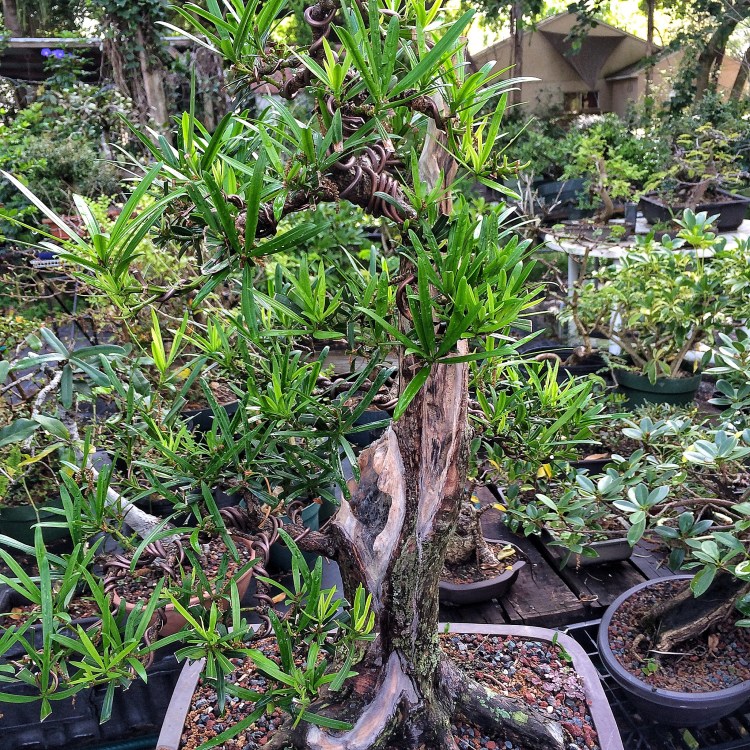 It’s a work in progress.
It’s a work in progress.
Next tree is a neea buxifolia.
 It has three things “bad” with it. It’s tropical, it’s normal growth habit is one of very rapid growth that shoots straight and up. It’s really hard to control the growth, so most people who turn these into bonsai just kinda hedge clip them. All silhouette, no structure. We call that topiary, not bonsai (although I did mention a technique called topiary/hedge trimming which is useful when trying to build ramification. But we always go back and adjust the structure after a season of this. At least I do).
It has three things “bad” with it. It’s tropical, it’s normal growth habit is one of very rapid growth that shoots straight and up. It’s really hard to control the growth, so most people who turn these into bonsai just kinda hedge clip them. All silhouette, no structure. We call that topiary, not bonsai (although I did mention a technique called topiary/hedge trimming which is useful when trying to build ramification. But we always go back and adjust the structure after a season of this. At least I do).
Are you ready for the really bad part of this tree? It’s like seeing the Wizard revealed
“PAY NO ATTENTION TO THE MAN BEHIND THE CURTAIN!”
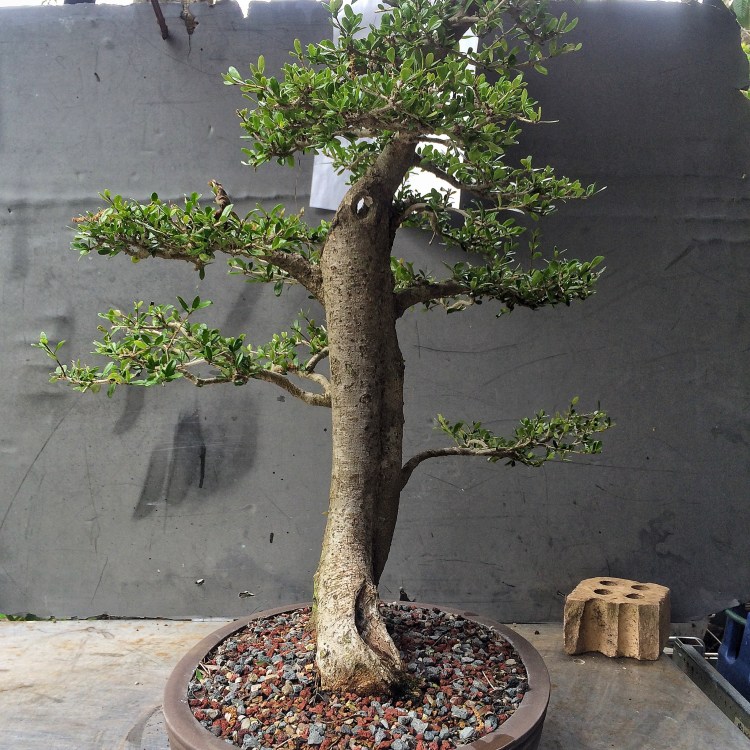
It’s not so bad from the other side.
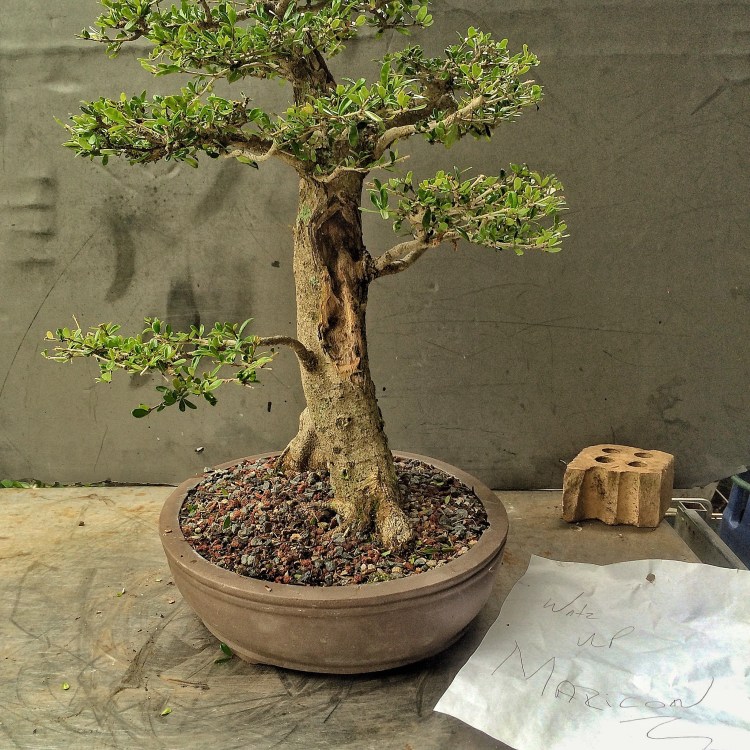
This was the tree that was on display at Epcot’s International Flower and Garden Show in 2014.
The next tree has a good reputation, it’s an American elm, and is usually considered to be desirable.
I collected it about two years ago and it’s growing well. But I posted a pic online and a surly Brit told me it was shite (unsolicited abuse, which is just rude. And very telling too; giving your opinion on a posting without the poster asking for opinions reveals how little you may really know. Kinda like the old adage: “It’s better to keep your mouth shut and be thought a fool than to open it and erase all doubt”. To use some more cliches: “Opinions are like assholes, everyone has them” and “Free advice is worth every penny you paid for it”. And, my favorite (like I tell my 18 year old boy all the time) “If I want any shit out of you, I’ll squeeze your head”. This isn’t to say that your tree or my tree is above critique; it’s just polite and respectful to ask if the poster would like advice/critiques before you give them. The Internet (and the world) is a mean enough place, we don’t have to add to it).
Here’s the elm.
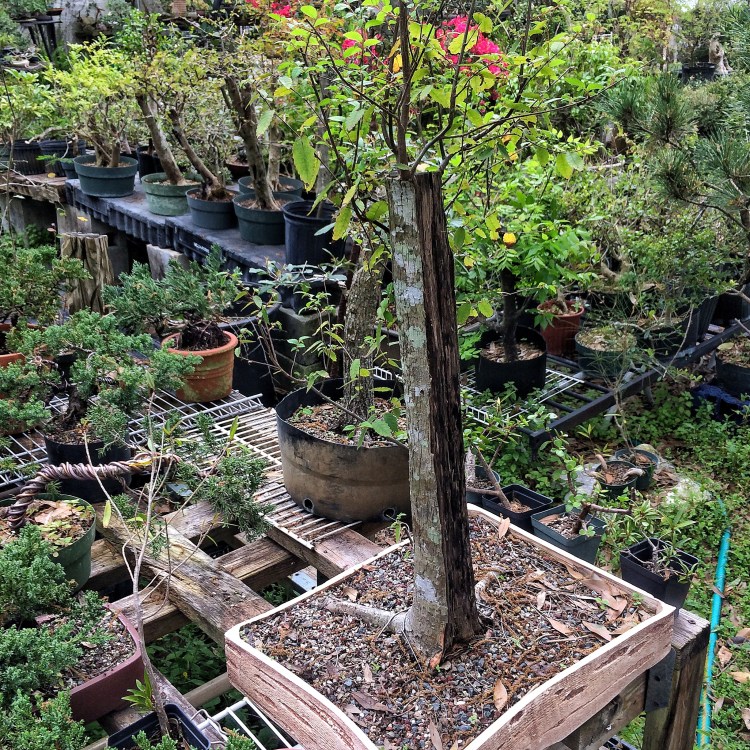
Wait, what?
Yup.
 ’Tis flat on the one side.
’Tis flat on the one side.
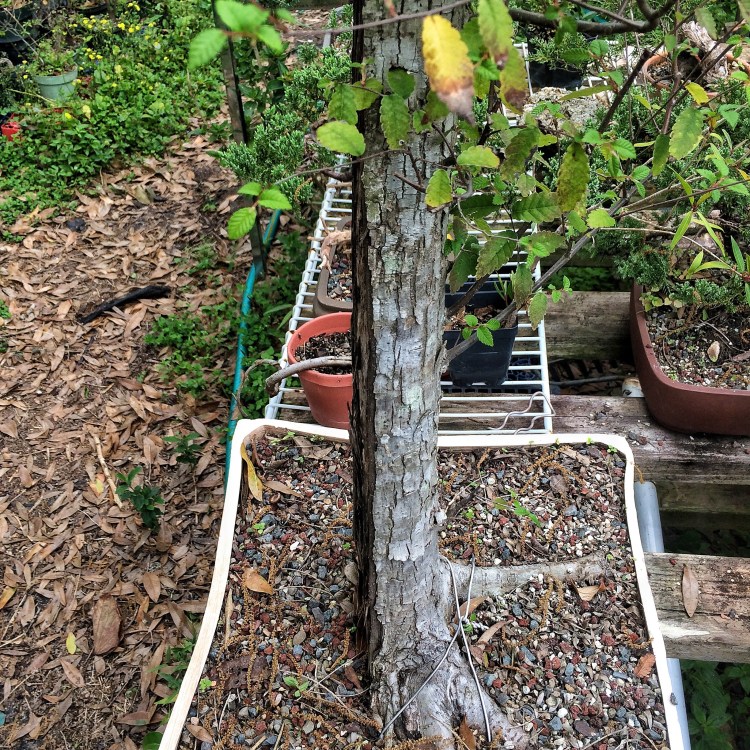 Whilst in the act of collection, yon tree did split and I did exclaim,
Whilst in the act of collection, yon tree did split and I did exclaim,
“Bollocks!” (See, I can converse in English too, with expletives even).

I really like this tree, even though it’s too tall, has no taper, has deadwood on a deciduous tree etc.
I think this will be one of my best.
The next tree is a laurel oak (quercus laurifolia). A deciduous oak native to Florida that most people confuse with a live oak. It has a lighter, less rough bark, longer and lighter in color leaves, and is considered short lived whereas a live oak can live hundreds of years.


 This tree might be a bit of a hybrid though (oaks are a bit slutty).
This tree might be a bit of a hybrid though (oaks are a bit slutty).
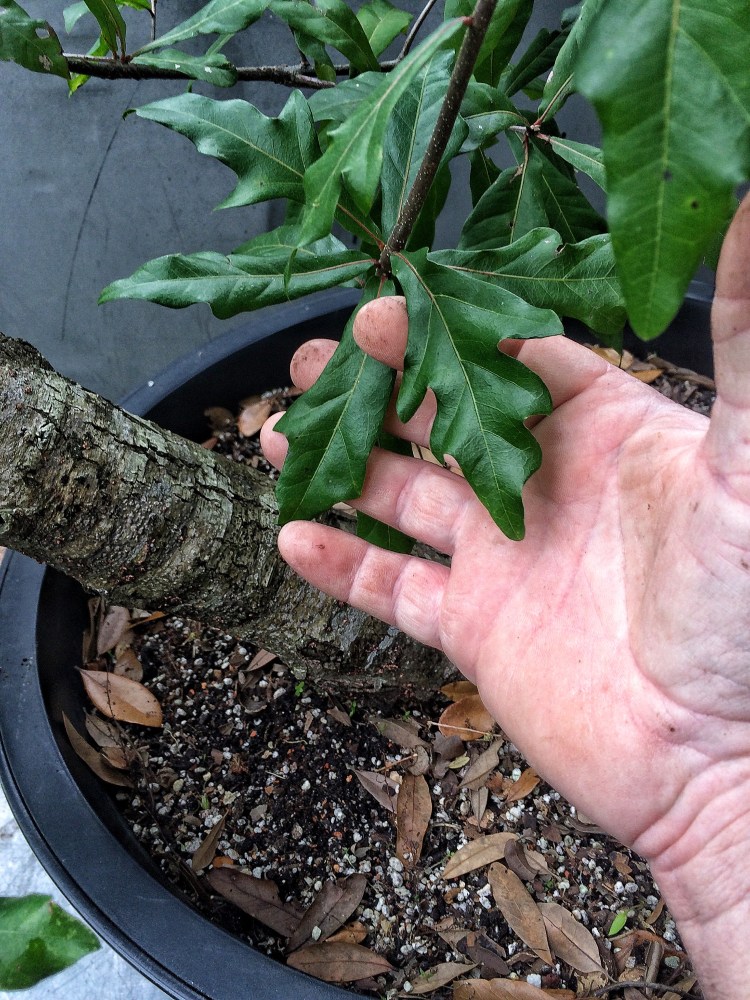 Looks like a bit of turkey oak in it.
Looks like a bit of turkey oak in it.
Let’s see what I can do.
First, a defoliation.

Then some carving I think.
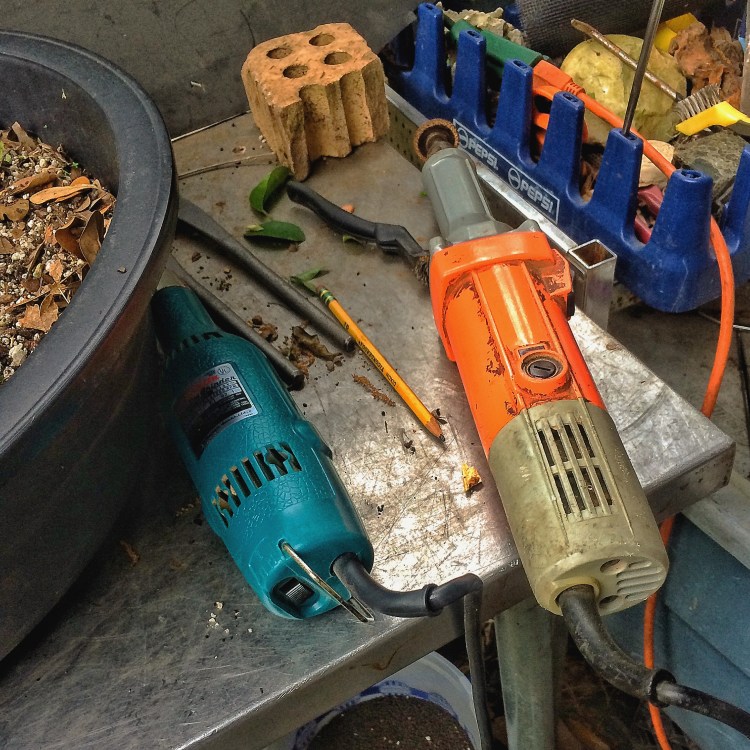
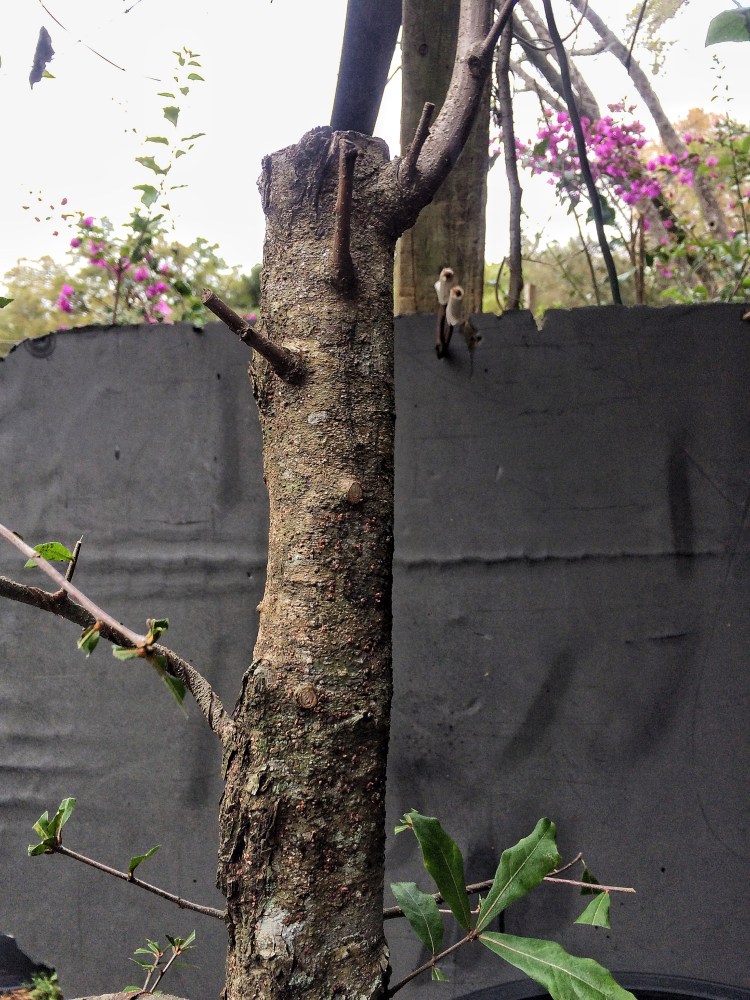
First pass.

Some hand tool work.
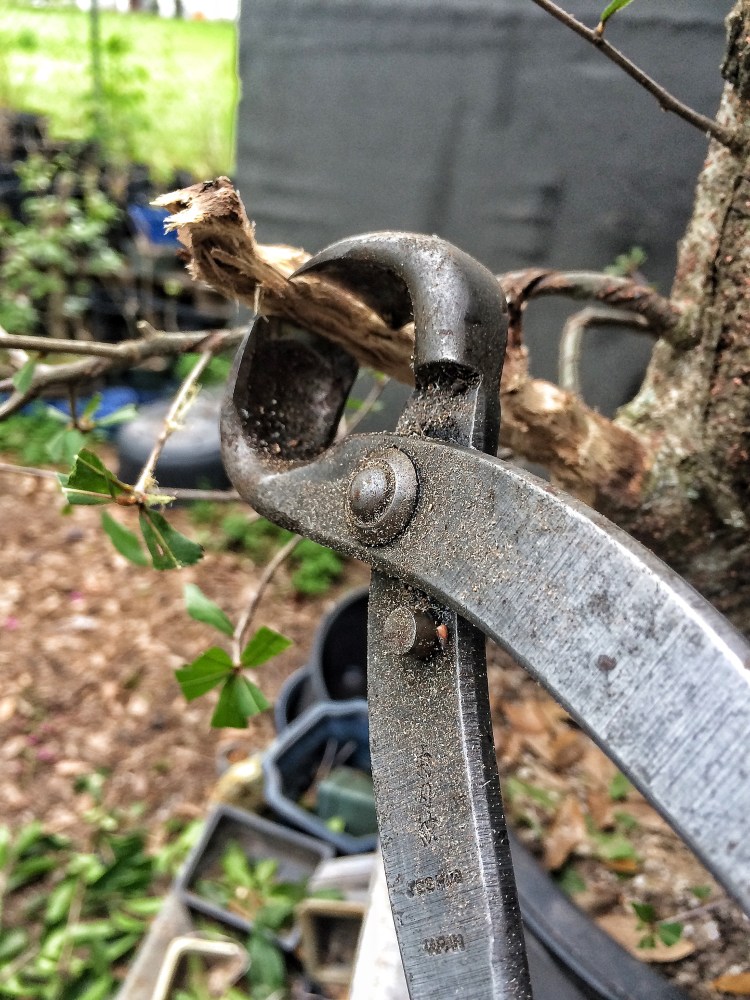
Almost there. Needs fire!


And just to answer the question before you ask, I use the torch to get those pithy fibers off and to remove the obvious tool marks. That’s all.
Brush brush brush

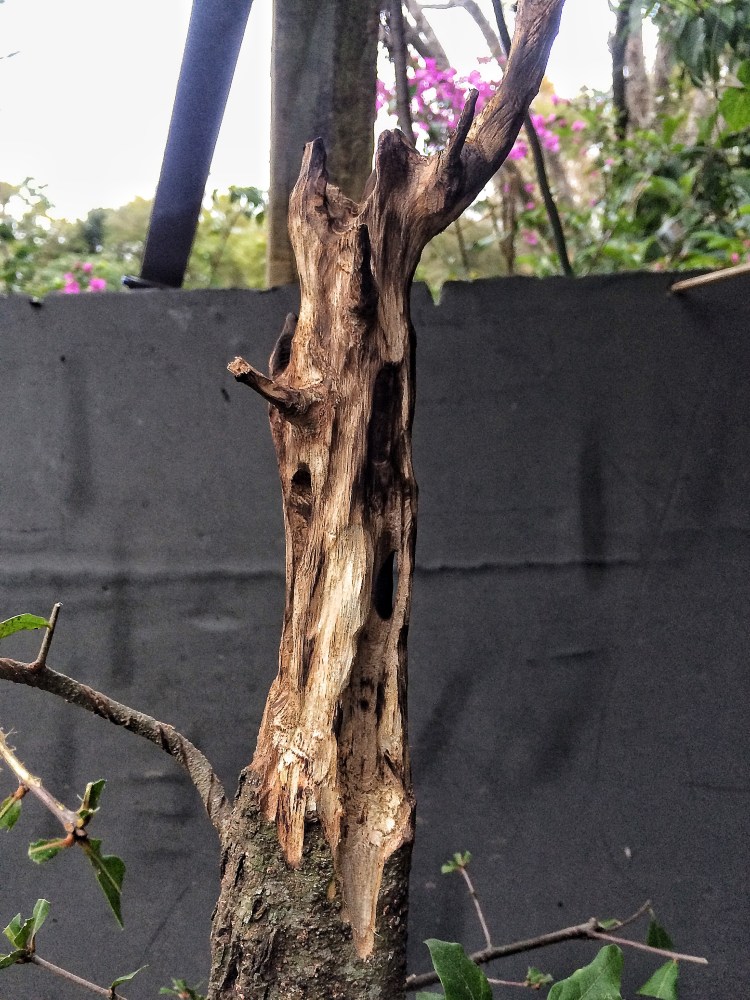

I’ll apply lime sulfur in the summer.
And now some wire.
 That’ll do. And that brings us to the end of the post too.
That’ll do. And that brings us to the end of the post too.
Oh, wait! The hackberry? Why is it a “bad tree”?
 It looks ok, doesnt it? It has movement, taper, branches.
It looks ok, doesnt it? It has movement, taper, branches.
There are some cuts that won’t heal (it being a hackberry and all)
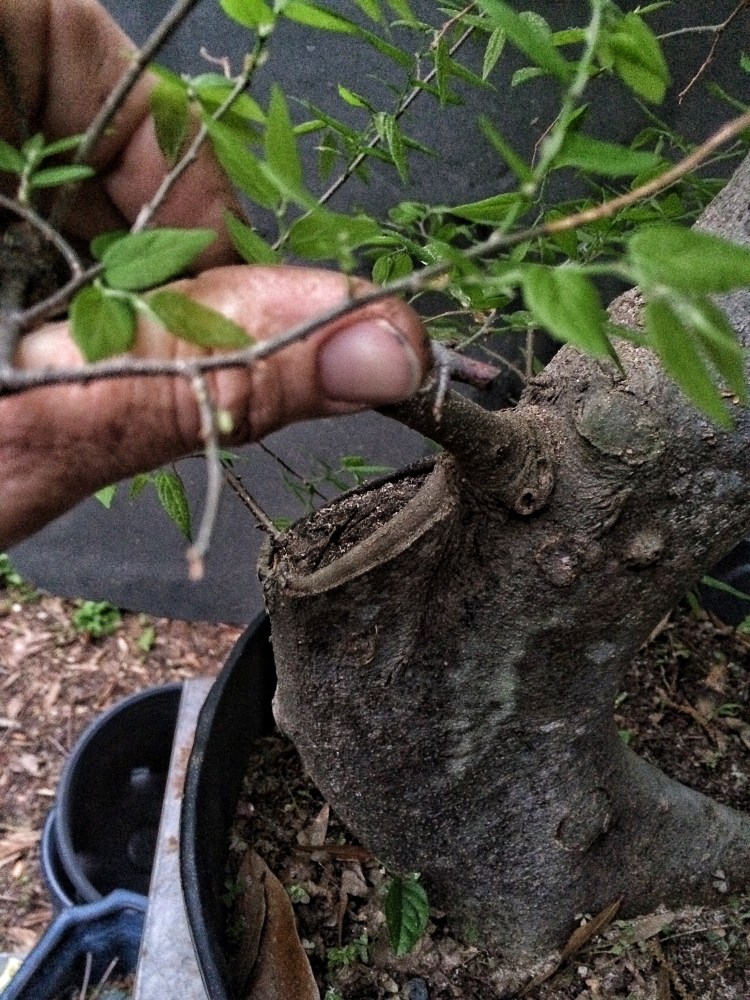

This particular specimen is not really suited for the classic deciduous tree style, and I know there are some real sticklers for styling a tree in the same way it grows naturally (not sure why people get so bent at this, this is an art you know).
Aside from that, here’s the reason that the bonsai police won’t like this tree.

It’s much like the neea from earlier.
Why, in my madness, do I want to work on trees that might be difficult? I could quote John F. Kennedy,
“We choose to (do these) things, not becawse they ahh easy, but becawse they ahh hahd.”
And that could be a good enough reason. It certainly worked to put a man on the moon.
I am an artist who works with trees. I’m not really a collector. I could care less about the value or the prestige my trees might have. My goal is to take a small, relatively young plant and make it look like a big, old tree. Sometimes the vision is fantastical (like Walter Pall’s fairytale trees) or sometimes they are stylized. Sometimes I try for a strict, naturalistic look, sometimes a caricature. It’s really the tree that tells me what to do. But I am not slavish to perfection; if a tree is bizarre, or hard to grow, or unique, there’s that much more of a challenge in bringing out its “treeishness”.
If I wanted easy, I’d just buy a tree. But, like I said, I’m not a collector.
And if we all followed the crowd and chose “acceptable” material, we wouldn’t be using japanese black pine (once considered “bad” because of its large needles…..until someone figured out the way to reduce them) or shimpaku juniper (the foliage was too much like a poodles pom poms).
For you just beginning in bonsai, it is a long, hard road to get a “bad” tree to become a good bonsai. That s-curve elm needs work, really. Your IKEA ginseng style ficus most probably needs about five years in a big pot or in the ground to mature that trunk. I’d advise you to cut off the grafted foliage and use the natural kind. That seedling (or worse, seed) you just bought on the Internet will take a long time to be a bonsai; it will be a long time before you even start real bonsai training on it, actually.
I recommend more developed trees in most cases. For myself though, I am not a beginner (not a master, by far, either, in fact, there are fewer masters in the bonsai world than you think. Even in Japan, most of them are specialist in a certain tree or trees. A true master can take a tree, regardless of its level of development, or its species, be it pine, ficus, maple, elm etc, and know what needs to be done to it, at that time, to further its way on its path to bonsai).
That last statement will get me in trouble, I guarantee it.
Anyway, that’s it for this post, sorry I teased you about the hackberry, again, but it’s pushed out its new leaves already. I’ll need to let them harden off a bit before I work on it; you’ll have to wait just a bit longer to see it styled.
Here’s another hackberry to tide you over. Many would consider it “bad” too.

I actually love that elm. American elms are everywhere here, since they were the easiest things to get to grow on the Great Plains when people moved out here and got a craving for trees, and having tried to eliminate an elm or two in an inappropriate spot I know how tightly they hang on to life. To me that elm just encapsulates the American elm… Which always seemed to me as I’d it would say “bite me, I’m still here” if it could talk.
LikeLike
Is this your foray into bonsai masochism?
LikeLike
Can I ask you a question about a tree I just collected?
LikeLike
Certainly
LikeLike
I’ve recently collected a black willow and put it in a pot. Unfortunately the only pot I could find was pretty shallow, but it should work for now. What do you think I should do with it? Some other people on a forum suggested cutting it down to a few trunk diamiters above the roots. This is it—>http://www.bonsainut.com/data/attachments/57/57907-a94a2378331e03f0c6d486841df0e6b5.jpg Sorry for the bad lighting. I couldn’t seem to find the right time of day to photograph it. It’s nine inches tall.
LikeLike
Can I ask you a question about a black willow I just collected?
LikeLike
Sorry for this duplicate comment. I got confused when I posted bothof them and I don’t know how to delete it.
LikeLike
Good article – every beginner should read it. Walter Pall
LikeLike
Thank you Walter, that means a lot
LikeLike
Personally. I think the Ficus you say needs a trim, is a good tree, great movement. The American Elm, I feel would make a “great” challenge to improve it.(I love Elms) I love the work you are doing on the Oak ,(why do a lot of people say that deciduous trees don’t look good with deadwood, have they never been out to the woods and forests?). Finally the last Hackberry is “Fabulous”…Hope you don’t mind my comments, I am a Brit and like what you do and say, I also agree with Walters comment about your article. Many years ago I was at a show and a relatively newbie to Bonsai was talking to Dan Barton about a tree she had bought, she had been told the best thing she could do with it was to put it on the fire..DB, asked her if she liked the tree, she said yes, to which his replied “Well, that’s all that matters”…True words. Would love to see further pics of all these trees as you improve them…Well done !
LikeLike
I have seen a lot of Bad trees available for sale to newbies – That is often all that they can afford and the store knows it. If we put down all the bad trees that came in with a new artist, how many would survive to become a regular member? How is your club growing, or is it just hanging on with old farts? I’ll bet Adam’s is growing and adding younger folks. I have advised new people who asked about them to stay away from certain trees because they are just a painstudy waiting to happen – and why, but I have never told anyone they have a bad tree or that they were wrong to get it. It’s just that it may take more skill than a beginner is likely to have to get to a satisfying result. Not all of us started out as masochists. And Walter is right. This should go in a beginners handout.
LikeLike
Ficus “ginsengů looks very suitable for air layering to obtain good “sumo” material. It is not any problem with air layering such big trunk.
LikeLike
Reblogged this on Tree in my palm.
LikeLike
Walter Pall commented on your blog!!!!!!!!!Wow wow wow and wow. Sorry, groupie moment there.
Loved the article and the encouragement it is to us beginners.
LikeLike
Reblogged this on Wolf's Birding and Bonsai Blog.
LikeLike